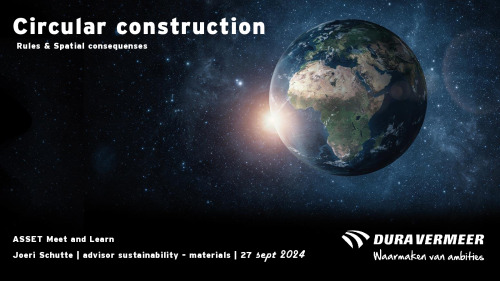When: Friday, 27 September 2024, 12:00 – 14:00 (CEST)
Where: You can see the recorded session in the Panel Sessions Section on the left.
Are you curious about the impact of the ‘storm’ of European laws and regulations coming our way regarding circular construction?
Sign up for a session on a new EU Position Paper on this topic and discover the latest developments and laws within the European Union that will affect the construction industry, both for companies and public authorities hosted by the Interreg ASSET ‘Meet&Learn’ platform.
We will discuss the reviewed Construction Products Regulation (CPR) as well as the impact of other relevant laws and regulations on decentralized authorities (such as cities and regions). In addition, we illustrate the opportunities for local authorities to promote circular construction, specifically within the field of public procurement and policies.
So sign up and discover how your municipality, metropolitan area or region can play a pioneering role toward a sustainable and circular future.
The Program of this series on CE Policies includes :
Part 1: Webinar session Online on September 27 (12:00-14:00 CET time)
Program available in the next page
Theme: Circular Economy and Construction in Urban Regions (CPR)
Participants: Experts on EU Policies / rules, spatial experts from Metrex regions
Part 2: 2-day event on 14-15 November 2024, in The Hague, NL
The Program is available at the following link
Part 1: Webinar session
Circular Economy and Construction in Urban Regions (CPR)
September 27, 2024 (12.00-14.00 CET time) by MS Teams
12.00 -12.10 Welcome and introduction to the Program
with Peter Pol, City of The Hague (program initiator)
and Henk Bouwman, METREX (moderator)
12.10-12.40 EU legal framework as concerns the circular economy regulation in the construction sector
With Eveline Bakker and Fanauw Hoppe, Circulaw, Expert on EU regulations in this sector, including presentation of draft position paper (20 min presentation, 10 min discussion)
12:40 -13:05 The Local authority level
With Chandar van der Zande, City of Amsterdam, Circular and Biobased Built Environment
(15 minutes presentation, 10 minutes discussion)
Explanation of circular construction case, spatial consequences and legal dimensions.
13.05-13.25 Construction, product, Investor
With Joeri Schutte, Dura Vermeer construction company (developer, contractor (15 minutes presentation, 10 minutes discussion) –
Explanation of circular construction case, spatial consequences and legal dimensions
13.25-13.50 Plenary discussion – interactive with f.i. break out rooms, polls, chat
Does the current EU -regulation help to stimulate circularity in the construction sector and to what spatial effects do it lead in urban regions?
Does it eventually lead to unwanted (spatial) side effects in urban regions?
What are good rules, rules that do not work, and desired new rules?
13.50-14.00 Main takeaways of the session and follow-up steps for the next physical conference on this theme
Preparatory Note
Explanation on the Circular Economy and construction sector
If we continue to use the resources we do now, we will need the resources of three planets of Earth by 2050. Due to resource constraints and climate issues, the EU aims to move from a ‘take-use-dispose’ society to a carbon-neutral, environmentally sustainable, toxic-free and fully circular economy by 2050 at the latest
Buildings account for: 50% of the extraction and consumption of resources and 40% of the EU’s energy consumption
- In December 2023, the Council and the Parliament reached a provisional agreement on the Commission’s proposed revision of the Construction Products Regulation. (CPR Construction Products Regulation, 305/2011)
- The new rules include requirements to ensure that construction products are designed and manufactured to become more durable and easier to repair, easier to recycle and reproducible.
- Manufacturers must:
- provide environmental information on the life cycle of products
- design and manufacture products in such a way as to facilitate reuse, reproduction and recycling
- Prefer recyclable materials
- Provide instructions for the use and repair of products
- We endorse the circularity goals of these regulations. It is important that these new regulations are drafted in such a way that circularity criteria can be included in public procurement without jeopardising the functioning of the internal market. This could be the case when vicinity of construction material will be a requirement for circularity.
- The functioning of the internal market creates tensions for circularity requirements in the construction industry in the first place. Heavy materials, such as building materials, will have to be recycled close to the source. How to stimulate this? Through regulations, trucosting, subsidies? How does this relate to the objectives of the internal market? (free traffic of goods)






